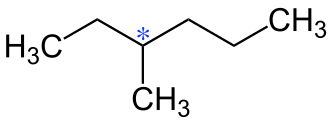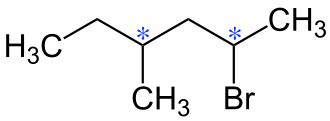Stereocenter

| Stereocenters |
 Two-dimensional presentation of 3-methylhexane having a chiral center on a carbon atom (with a blue labeled asterisk ( ✱ in)). |
 Two-dimensional presentation of 2-bromo-4-methylhexane with two stereocenters on carbon atoms (each marked with blue asterisks ( ✱ )). |
In stereochemistry, a point in a molecule with a set of substituents in such a spatial arrangement that it cannot be brought into congruence with the mirror-image arrangement is called a stereocenter (also chirality center or stereogenic center / atom ) .
The stereocenter does not necessarily have to coincide with an atom , but can also lie between several atoms (see below: double bond).
to form
A common form of the stereocenter is the asymmetrically substituted carbon atom that has four different substituents, e.g. B. a hydrogen atom (H), a methyl radical (CH 3 ), an ethyl radical (CH 2 CH 3 ) and a propyl radical (CH 2 CH 2 CH 3 ). In this context, the formally incorrect designation of the asymmetric carbon atom is often used. However, the term is historically shaped and goes back to Jacobus Henricus van 't Hoff .
The term substituent is to be interpreted broadly and also includes free electron pairs . Therefore, not only four-bond, tetrahedrally coordinated carbon atoms or quaternary ammonium compounds of the amine type can be centers of chirality, but also pyramidal coordinated atoms such as. B. nitrogen atoms in sterically hindered amines , phosphorus atoms in phosphines or sulfur atoms in sulfoxides .
A double bond can also represent a stereocenter; it is then referred to as a stereogenic double bond. According to the Cahn-Ingold-Prelog Convention the resulting two stereoisomers are marked with ( E ) (of E ntgegen) or ( Z (from) Z ogether).
An asterisk is usually used to denote a stereocenter in structural formulas. However, IUPAC does not recommend this designation unless the meaning of the star is clear from the given context. The nomenclature of the configuration of a stereocenter is based on the Cahn-Ingold-Prelog convention .
While a single stereocenter always results in a chiral molecule, the presence of several stereocenters does not necessarily lead to a chiral structure. If there are several mirror-image stereocenters within the molecule, then there is an achiral meso compound .
Conversely, there are also chiral compounds without a chiral center, which then have an axial , helical or planar chirality .
There are stereoisomers of compounds with stereocenters . If stereoisomers are mirror images of one another, they are referred to as enantiomers , otherwise they are referred to as diastereomers .
Stereocenters can be formed either specifically ( stereospecificity ) or preferentially ( stereoselectivity ) in chemical reactions . Reactions in which the possible configurations of a stereocenter are formed with equal frequency are called stereospecific.
number
The number of maximum possible stereoisomers of a molecule can be calculated from the number of its stereocenters:
- A molecule with n stereocenters has 2 n stereoisomers. The 2 n stereoisomers form 2 n-1 enantiomer pairs which are diasteromeric to one another.
The structure of 2-bromo-4-methylhexane (n = 2 stereocenters) shown on the right therefore has 2 2 = 4 different stereoisomers. These form 2 2-1 = 2 enantiomer pairs that are diastereomeric to one another.
The actual number of stereocenters can be lower, for example through meso compounds or through links between the stereocenters, as is possible with heterocycles .
Individual evidence
- ↑ Entry on chirality center . In: IUPAC Compendium of Chemical Terminology (the “Gold Book”) . doi : 10.1351 / goldbook.C01060 Version: 2.1.5.
- ^ Karl-Heinz Hellwich: Stereochemistry: Basic Concepts . Springer-Verlag, Heidelberg, Berlin 2002, ISBN 3-540-42347-8 , pp. 21 .
- ^ Peter J. Ramberg: Chemical Structure, Spatial Arrangement: The Early History of Stereochemistry, 1874-1914 . Ashgate Publishing, Aldershot 2003, ISBN 0-7546-0397-0 , pp. 57 ( limited preview in Google Book search).
- ↑ Ursula Bünzli-Trepp: Systematic Nomenclature of Organic, Organometallic and Coordination Chemistry: Chemical Abstracts Guidelines and Iupac Recommendations and Many Trivial Names . EPFL Press, 2007, ISBN 978-1-4200-4615-1 ( page 560 in the Google book search).
- ↑ a b Paula Yurkanis Bruice: Organic Chemistry: Study compact . Pearson Deutschland GmbH, 2011, ISBN 978-3-86894-103-6 ( page 131 in the Google book search).
- ↑ Jonathan Brecher: Graphical representation standards for chemical structure diagrams (IUPAC Recommendations 2008) . In: Pure Appl. Chem. Band 80 , no. 2 , 2008, p. 277-410 , doi : 10.1351 / pac200880020277 .
- ↑ Gerhard Hilt, Peter Rinze: Chemical internship for physicians . Springer, 2012, ISBN 978-3-8348-0667-3 ( page 153 in the Google book search).
